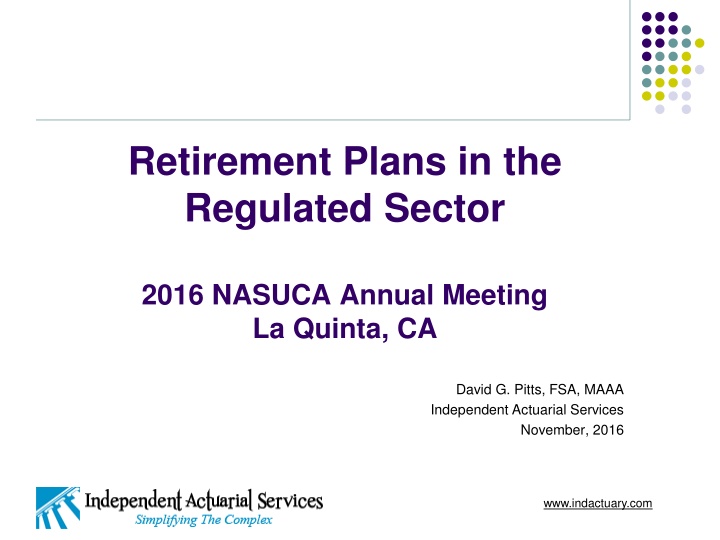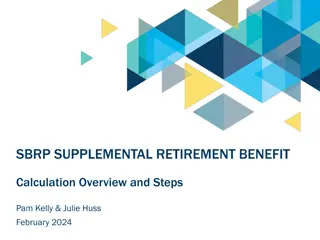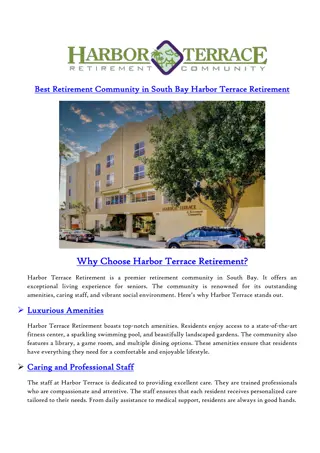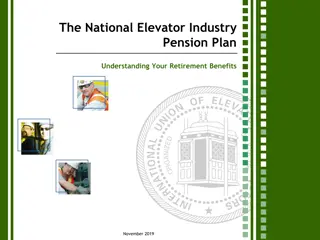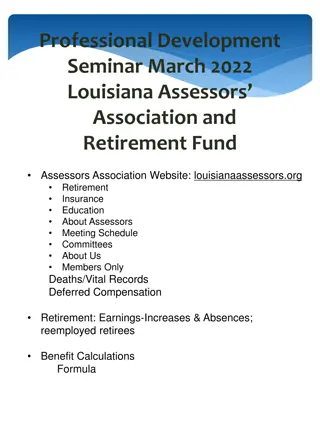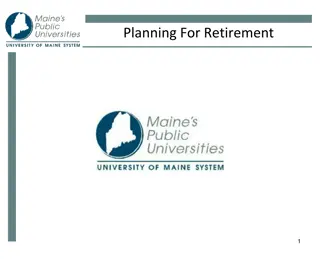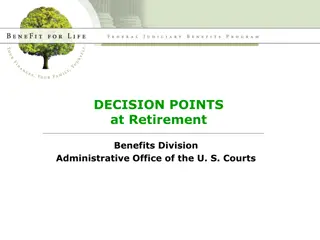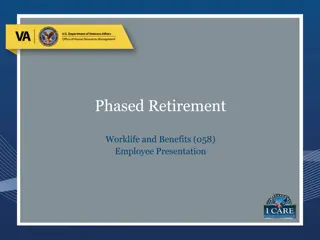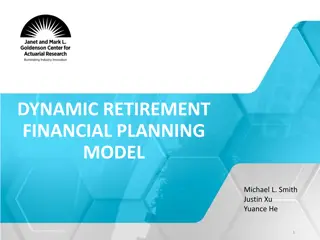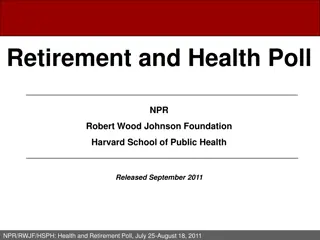Insights into Retirement Plans in the Regulated Sector
Explore the dynamics of Defined Benefit (DB) and Defined Contribution (DC) retirement plans in the regulated sector, focusing on trends, key considerations, per capita costs, and the complexities of managing DB costs. Learn about the shift from DB to DC plans, derisking strategies, and the impact on ratepayers in this comprehensive overview.
Download Presentation

Please find below an Image/Link to download the presentation.
The content on the website is provided AS IS for your information and personal use only. It may not be sold, licensed, or shared on other websites without obtaining consent from the author.If you encounter any issues during the download, it is possible that the publisher has removed the file from their server.
You are allowed to download the files provided on this website for personal or commercial use, subject to the condition that they are used lawfully. All files are the property of their respective owners.
The content on the website is provided AS IS for your information and personal use only. It may not be sold, licensed, or shared on other websites without obtaining consent from the author.
E N D
Presentation Transcript
Retirement Plans in the Regulated Sector 2016 NASUCA Annual Meeting La Quinta, CA David G. Pitts, FSA, MAAA Independent Actuarial Services November, 2016 www.indactuary.com
Retirement Plans Two main types Defined Benefit (DB): employer promises to provide a specific benefit, e.g., 1.2% of final avg pay x yrs of service, payable for life Defined Contribution (DC): employer promises to provide a specific contribution, e.g., 50% match up to 6% of elective salary deferrals Qualified plans subject to ERISA (vesting, nondiscrimination, disclosure, funding, etc.) All plans subject to GAAP 2
General Trends DB promises phased out and replaced by DC plans (or formulas) DB plan derisking in response to 2008 crisis and changes in funding and GAAP Liability Driven Investment / other ALM Risk transfer (lump sums, annuity purchases) New features to address DC shortcomings Lifecycle investment strategies Auto enrollment / escalation 3
Key Considerations for Regulated Sector Are retirement benefits reasonable or overly generous? Are costs being shifted to future generations of ratepayers? Are the financing aspects detrimental to ratepayers? Have events (e.g., acquisitions, terminations) been properly accounted for? 4
Survey of Per Capita Costs Lack of transparency makes it difficult to assess whether company is appropriately managing compensation costs Per-capita retirement costs Sector Average Per Capita Retirement Costs $15,000 $12,000 $4,000 Cost Relative to regulated utility 100% Regulated Utility Non-regulated Utility General Business 80% 27% 6
DB Costs The cost of a DB plan is equal to the present value of the retirement benefits Retirement benefits dependent on retirees in pay status, amount of check, etc. Mortality, disability, turnover, etc. used to estimate future payment amounts Interest discount used to determine present value Contributions and FAS87 are NOT the cost 7
Three Sets of Books Interest discount assumption typically understates cost Cashflows equal in amount, timing, and probability of receipt should be priced equally FAS87 does not include the price of risk, allowing companies to understate DB cost PPA average yields also understate costs Risk-free rate is appropriate measure; consistent with annuity transfer pricing 8
Flexible Cost Allocation Cash Complex rules, frequent changes in law, relaxed standards in response to financial crisis ERISA funding requirement a misnomer; in practice, tremendous flexibility Expense Smoothing mechanisms not built for shocks Faster amortizations permitted Company latitude over cash and expense 9
Cash vs. Expense FAS87 income in early years created prepaid pension assets FAS87 cost in later years nowhere near sufficient Smoothing and deferral mechanisms inadequate for shocks Cash contributions well in excess of FAS87 PNM FAS87 vs Cash ($Millions) Source: 10-k 90 80 70 60 50 40 30 20 10 0 2004 2005 2006 2007 2008 2009 2010 2011 2012 2013 2014 2015 -10 -20 FAS87 Expense Cash Contribution 10
Prepaid Pension Asset Company testimony A prepaid pension asset represents the difference between: (1) the cumulative cash amounts contributed to the pension fund, and (2) the cumulative actuarially determined net periodic pension cost calculated in accordance with FAS 87. Translation A prepaid pension asset is an obligation owed to the Company, often times interest bearing at above market rates In addition to deficits owed to plan trust 11
Why Should I Care Prepaid pension assets: Have grown exponentially since 2007 Will persist for decades under current accounting and funding regimes Locked in source of risk-free profits for company Represents growing intergenerational inequity Pervasive and hotly contested Recent wins in Colorado electric and gas jurisdictions (PSCo) 12
Underlying Economics Company can earn spread on prepaid pension asset Can borrow at cost-of-debt, with tax deductible interest charges And earn an after-tax return of WACC for the shareholder investment Ratepayers are captive borrowers Forced to borrow at rates > 10% Penalty rates compared to credit worthiness 13
How Did We Get Here Rise in overall pension debt Asset/liability mismanagement Increased longevity? Regulatory inertia Complicated, lack of transparency Arcane accounting and funding standards Agency problem Hotly contested Profit center for company 14
Colorado Ruling Prepaid Pension Asset: Legacy and New Legacy Prepaid Equals Prepaid Pension Asset as of 12/31/2014 15 year amortization (post-tax) Cost of debt vs. WACC Interest charge to be renegotiated in 2017 New Prepaid is non-interest bearing 15
Colorado Ruling Before: $156 M After: 51 M Savings: $105 M 16
Acquisition Example Accrued Pension Cost of $20 million at acquisition Ratepayers paid $20 million in rates that had not yet been contributed to pension fund Purchase accounting wipes out all unrecognized amounts at AD Unrecognized losses, prior service cost integrated into Goodwill FAS87 amortizations = $0 at AD 17
Acquisition Example Company set up regulatory asset equal to unrecognized amounts of $10 million Ratepayers continued to pay pre-acquisition amortization amounts, presumably under theory that rates were not affected by acquisition Company claimed treatment was required by GAAP Amortization payments were not contributed to pension trust, nor were they disclosed under FAS87 18
Acquisition Example Company effectively stole $27 million in ratepayer money The $20 million at AD that had been collected but never contributed to pension fund The $7 million in post AD amortizations that went toward regulatory asset as opposed to pension fund Highlights importance of maintaining pension financial statement for ratepayer 19
David G. Pitts, FSA David Pitts has provided actuarial consulting services to Fortune 500 companies for more than 25 years, assisting the Human Resource and Finance functions in the design, pricing, risk management, communication and administration of pension and other compensation programs. In 2010, David launched Independent Actuarial Services, focusing primarily on the actuarial needs of the legal community. In this role, David has served as a consultant and expert witness representing utility ratepayers in both Colorado and New Mexico, and has served as a forensic economist in civil matters ranging from wrongful termination to personal injury claims. David received his BS in Mathematics from Tufts University, and is a Fellow in the Society of Actuaries. David is a regular speaker at actuarial conferences, and has served on the Pension Finance Task Force a sponsored committee whose primary mission is to strengthen retirement systems, by incorporating the teachings of financial economics into traditional retirement actuarial practice. David also serves as the retirement expert for the SOA curriculum committee on enterprise risk management. www.indactuary.com 917-371-3154
